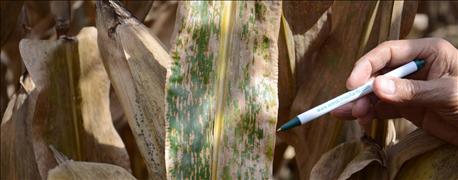
You’re hot, dirty and tired. Who wouldn’t be after harvesting corn with more disease than usual in most of the state? Even those of you who harvested good yields likely saw evidence of significant disease pressure. Farmers in Indiana's southern counties saw yield prospects crushed by a host of reasons, including southern rust. Who wouldn’t be tempted to unchain the rusty moldboard plow from the tree? Or at least get out the chisel plow?

RAMPANT DISEASE LATE: Many leaves looked like this before harvest. However, experts say plowing residue under isn’t the answer to controlling disease next year.
Kiersten Wise, Purdue University Extension plant pathologist, says even if it made you feel better, it would likely do precious little toward minimizing disease in 2017. “Some diseases don’t overwinter here anyway, and even if they do, there are several options to protect the crop next year.
“The other half of the equation is that we really can’t predict what disease conditions will be like and which will prosper a year in advance. The biggest factor which will determine disease pressure next year will be weather conditions that unfurl in 2017," Wise explains.
Here are three key things you should know about preparing for potential disease threats next year.
1. Understand the life cycle of the disease.
Southern rust and common rust blow up from the Southern states each year, Wise says. The fungi that cause these diseases don’t overwinter in Indiana because fungi need a living host to survive. Once corn dies, the fungi lose their host. If the only reason you’re tilling is because your crop was choked with southern rust and you want to destroy the causal organisms, you’re wasting time, money and fuel, she says. There is no correlation between whether or not either one of these rusts causes a problem in any one season, because storm patterns next summer determine if these disease threats will arrive in strong enough numbers and in time to cause damage. Residue left in the field from the previous year plays no role.
“Agronomists who thought that southern rust and other diseases which came in fairly late this year wouldn’t cause much yield loss weren’t wrong,” Wise insists. “Sometimes we just can’t predict what the weather will do. Conditions, especially in southern counties, lined up to favor the disease very late in the season.”
2. Don’t forget about northern corn leaf blight.
This foliar disease was more prevalent in the previous couple of seasons than in 2016, Wise notes. “It’s favored by cool weather, and we didn’t have that this year.”
That doesn’t mean you can forget about it, she emphasizes. Wise recommends paying attention to how much resistance hybrids have to northern corn leaf blight when you are making hybrid selections for 2017.
3. Gray leaf spot deserves special attention.
Since it prefers warmer, humid weather, gray leaf spot took off in many areas this season, even if it came in late and wasn’t a factor early on. Fungi causing both northern corn leaf blight and gray leaf spot overwinter in corn residue.
“The best advice is to sit down with your seedsman and make resistance to gray leaf spot a top priority when selecting hybrids,” Wise recommends. “You need to know how hybrids you select stand up to this disease.
“It’s even more critical if you’re in a conservation-tillage system with more than 30% residue cover, or in continuous corn.”
About the Author(s)
You May Also Like




